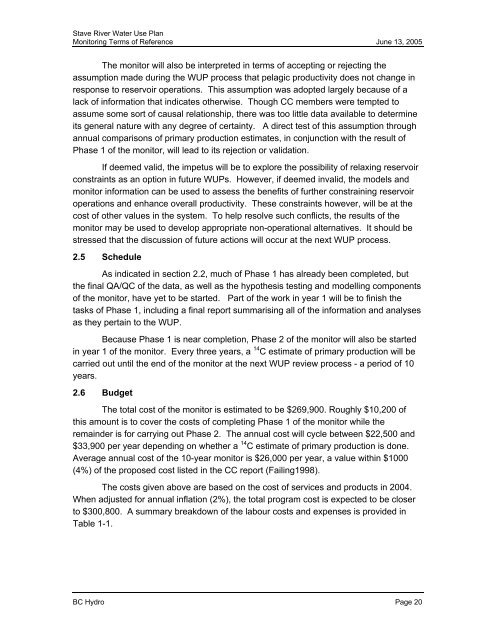Stave River Water Use Plan - BC Hydro
Stave River Water Use Plan - BC Hydro
Stave River Water Use Plan - BC Hydro
You also want an ePaper? Increase the reach of your titles
YUMPU automatically turns print PDFs into web optimized ePapers that Google loves.
<strong>Stave</strong> <strong>River</strong> <strong>Water</strong> <strong>Use</strong> <strong>Plan</strong><br />
Monitoring Terms of Reference June 13, 2005<br />
The monitor will also be interpreted in terms of accepting or rejecting the<br />
assumption made during the WUP process that pelagic productivity does not change in<br />
response to reservoir operations. This assumption was adopted largely because of a<br />
lack of information that indicates otherwise. Though CC members were tempted to<br />
assume some sort of causal relationship, there was too little data available to determine<br />
its general nature with any degree of certainty. A direct test of this assumption through<br />
annual comparisons of primary production estimates, in conjunction with the result of<br />
Phase 1 of the monitor, will lead to its rejection or validation.<br />
If deemed valid, the impetus will be to explore the possibility of relaxing reservoir<br />
constraints as an option in future WUPs. However, if deemed invalid, the models and<br />
monitor information can be used to assess the benefits of further constraining reservoir<br />
operations and enhance overall productivity. These constraints however, will be at the<br />
cost of other values in the system. To help resolve such conflicts, the results of the<br />
monitor may be used to develop appropriate non-operational alternatives. It should be<br />
stressed that the discussion of future actions will occur at the next WUP process.<br />
2.5 Schedule<br />
As indicated in section 2.2, much of Phase 1 has already been completed, but<br />
the final QA/QC of the data, as well as the hypothesis testing and modelling components<br />
of the monitor, have yet to be started. Part of the work in year 1 will be to finish the<br />
tasks of Phase 1, including a final report summarising all of the information and analyses<br />
as they pertain to the WUP.<br />
Because Phase 1 is near completion, Phase 2 of the monitor will also be started<br />
in year 1 of the monitor. Every three years, a 14 C estimate of primary production will be<br />
carried out until the end of the monitor at the next WUP review process - a period of 10<br />
years.<br />
2.6 Budget<br />
The total cost of the monitor is estimated to be $269,900. Roughly $10,200 of<br />
this amount is to cover the costs of completing Phase 1 of the monitor while the<br />
remainder is for carrying out Phase 2. The annual cost will cycle between $22,500 and<br />
$33,900 per year depending on whether a 14 C estimate of primary production is done.<br />
Average annual cost of the 10-year monitor is $26,000 per year, a value within $1000<br />
(4%) of the proposed cost listed in the CC report (Failing1998).<br />
The costs given above are based on the cost of services and products in 2004.<br />
When adjusted for annual inflation (2%), the total program cost is expected to be closer<br />
to $300,800. A summary breakdown of the labour costs and expenses is provided in<br />
Table 1-1.<br />
<strong>BC</strong> <strong>Hydro</strong> Page 20
















